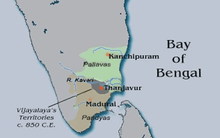Vijayalaya Chola
Vijayalaya Chola was a king of South India (r. 850 – 870 CE) who founded the imperial Chola Empire.[1] He ruled over the region to the north of the river Kaveri.
| Vijayalaya Chola | |
|---|---|
| Parakesari | |
 Vijayalaya's Territories c. 850 CE | |
| Reign | c. 850 – c. 870 CE |
| Successor | Aditya I |
| Born | uraiyur |
| Died | 871 CE Kalahasti |
| Issue | Aditya I |
| List of Chola kings and emperors | ||||||||||||||||||||||||||||
|---|---|---|---|---|---|---|---|---|---|---|---|---|---|---|---|---|---|---|---|---|---|---|---|---|---|---|---|---|
| Early Cholas | ||||||||||||||||||||||||||||
| Interregnum (c. 200 – c. 848) | ||||||||||||||||||||||||||||
| Medieval Cholas | ||||||||||||||||||||||||||||
|
||||||||||||||||||||||||||||
| Later Cholas | ||||||||||||||||||||||||||||
|
||||||||||||||||||||||||||||
| Related dynasties | ||||||||||||||||||||||||||||
|
||||||||||||||||||||||||||||
| Chola society | ||||||||||||||||||||||||||||
Dark age of Cholas
The ancient Chola kingdom once famous in Tamil literature and in the writings of Greek merchants and geographers faded into darkness after c. 300 CE. Cholas during this period almost completely disappeared from their native land. They seem to have held on to their old capital city of Urayur. This "dark" age of Tamil history came to an end with the ascendancy of the Pandyas and the Pallavas. The Cholas had to wait for another three centuries until the accession of Vijayalaya in the second quarter of the ninth century to re-establish their dynasty.
Cholas under Pandyas and Pallavas
We know very little of the fate of the Cholas in this long interval. What is certain however is that when the power of Cholas fell to the lowest ebb and that of the Pandyas and Pallavas rose to the north and south of them, this ancient dynasty was compelled to seek refuge and patronage under their more successful rivals. The Cholas, though not prominent or powerful as they were earlier were not completely in danger of extinction and continued to hold sway over a limited area consisting of what are the districts of Mayiladuturai, Chidambaram, Thanjavur, Tiruchy and Pudukkottai in modern Tamil Nadu.
Rise of Vijayalaya Chola
Making use of the opportunity during a war between Pandyas and Pallavas, Vijayalaya rose out of obscurity and captured Thanjavur. At this time there was a great struggle going on between the Pallavas and the Pandyas for the political supremacy of South India. In this disturbed state of affairs, Vijayalaya seems to have found a good opportunity to defeat the Pandyas, and make himself the ruler of Thanjavur and the surrounding Chola country. He also defeated the Pallavas.
Vijayalaya Chola conquered Thanjavur from Elango Mutharaiyar who was the final ruler of Mutharaiyar dynasty. It is said that in the year 852 CE Vijayalaya Chola waged war with Pandya's and defeated the latter. Making use of the opportunity during a war between Pandyas and Pallavas, Vijayalaya rose and established the Chola kingdom at Thanjavur with help of Muttaraiyar king Sattan Paliyilli (826–852 CE). Cholas became so powerful that the Pallavas were also wiped out from the Thanjavur region at a later stage.
Pandyan invasion
After Vijayalaya’s capture of Thanjavur, the Pandyan king Varagunavarman II (c. 862 – 885 CE) became a subordinate ally of the Pallava Nandivarman III (c. 846 – 869 CE). Nandhivarman wished to curtail the growing influence of Chola power under Vijayalaya and called upon the Varagunavarman to help suppress Vijayalaya. Varaguna led an expedition into the Chola country. The Pandyan army reached the north bank of the Kaveri near Thanjavur and for a while the Chola revival looked short lived. Vijayalaya, by this time a veteran of many battles, was aging and was an invalid. The crown prince Aditya I took control of the army in the defence of the Chola kingdom. Vijayalaya was succeeded after his death c. 871 CE by his son Aditya I.
Inscriptions of Vijayalaya
The Tiruvalangadu plates state that Vijayalaya captured the city of Tanjavur and made it his capital and that he also built in it a temple to the goddess Nisumbhasudani (Durga). The Kanyakumari inscription states that he renovated the city of Tanjore.
Vijayalaya took the title of Parakesarivarman. Chola kings succeeding him took the titles of Parakesari and Rajakesari in turns. This is probably to acknowledge their supposed ancestors Parakesari and Rjakesari.
Narttamalai, Pudukkottai has a solesvara temple attributed to Vijayalaya.
Notes
- Sen, Sailendra (2013). A Textbook of Medieval Indian History. Primus Books. p. 46-49. ISBN 978-9-38060-734-4.
References
- Tamil And Sanskrit Inscriptions Chiefly Collected In 1886 - 87, E. Hultzsch, Ph.D., Published by Archaeological Survey of India, New Delhi
- Nilakanta Sastri, K. A. (1935). The CōĻas, University of Madras, Madras (Reprinted 1984).
- Nilakanta Sastri, K. A. (1955). A History of South India, OUP, New Delhi (Reprinted 2002).
| Preceded by Pandya Pallava |
Chola 848–871 CE |
Succeeded by Aditya I |